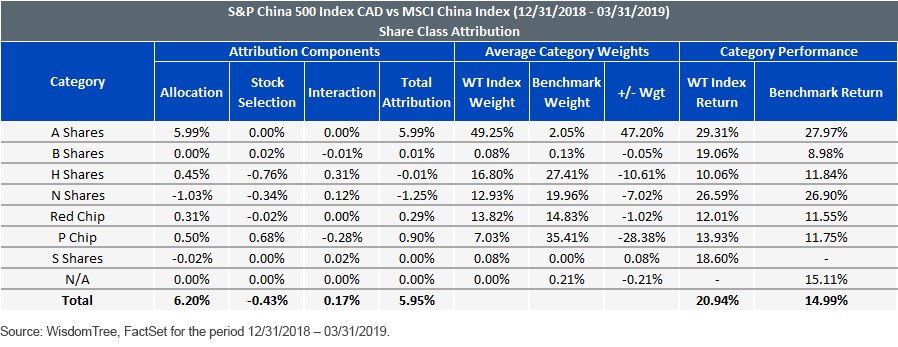By WisdomTree ETFs
Special to the Financial Independence Hub
While we remain optimistic that a U.S.–China trade deal will ultimately be reached, investors need greater transparency into what’s performing (or not) in the Chinese equity market. In this article we break down performance by a variety of factors including share class.
In December 2017, WisdomTree partnered with Standard & Poor’s (S&P) to launch the most inclusive Chinese beta product that tracks the S&P China 500 Index.
The WisdomTree ICBCCS S&P China 500 Index ETF, CHNA.B, gives investors seeking a beta exposure to Chinese equities access to the broadest diversity of opportunities in the market by investing in H-shares, B-shares, A-shares and P-chips: shares listed in Hong Kong, Shanghai, Shenzhen, Singapore and New York.
Share Class Attribution
There was a great deal of market interest when MSCI announced they would start to include A-shares in the summer of 2017. Since then, current A-share exposure in the MSCI China Index is just over 2%, despite A-shares representing the largest segment of the Chinese equity market. In our view, the S&P China 500 Index provides a more representative exposure by allocating close to 50% to mainland shares.
Breaking down exposures by share class, you can see the impact of gaining broad access to the Chinese equity market. In the performance attribution table below, we can see how the S&P China 500 Index has a more balanced exposure across the different share classes than the MSCI China Index, which limits its exposure to class A-shares.
Since the beginning of 2019, the Chinese equity market has experienced strong growth, and the S&P China 500 Index has been in the best position to take advantage of this rebound, having nearly 50% exposure to class A-shares versus the MSCI China Index’s 2.05% exposure. This allocation was the primary driver for the almost 600 basis points (bps) of outperformance that the S&P China 500 Index had in the first quarter of the year.
Better value and higher quality
Another consequence of having an increased exposure to class A-shares comes in the form of better valuations and increased quality as measured by price-to-earnings (P/E) and return on equity (ROE), respectively. As shown below, we can see that over the past year, the S&P China 500 Index has had higher average exposure to the highest ROE quintile, while also being underweight in the lowest ROE quintile and negative earners.
Average Portfolio Weight – ROE Quintlies
In terms of P/E quintiles, we can see that having a better valuation and lower exposure to the most expensive (highest P/E) quintile has translated into outperformance since the beginning of the year.
In our view, there will continue to be increased convergence between the role that China plays in the global economy and the role it plays in global portfolios. Through our collaboration with S&P, we are able to provide exposure to the most inclusive Chinese beta product that tracks the S&P China 500 Index.
Commissions, management fees and expenses all may be associated with investing in WisdomTree ETFs. Please read the relevant prospectus before investing. WisdomTree ETFs are not guaranteed, their values change frequently and past performance may not be repeated. Past performance is not indicative of future results. This material contains the opinions of the author, which are subject to change, and should not to be considered or interpreted as a recommendation to participate in any particular trading strategy, or deemed to be an offer or sale of any investment product and it should not be relied on as such. There is no guarantee that any strategies discussed will work under all market conditions. This material represents an assessment of the market environment at a specific time and is not intended to be a forecast of future events or a guarantee of future results. This material should not be relied upon as research or investment advice regarding any security in particular. The user of this information assumes the entire risk of any use made of the information provided herein. Neither WisdomTree nor its affiliates provide tax or legal advice. Investors seeking tax or legal advice should consult their tax or legal advisor. Unless expressly stated otherwise the opinions, interpretations or findings expressed herein do not necessarily represent the views of WisdomTree or any of its affiliates. “WisdomTree” is a marketing name used by WisdomTree Investments, Inc. and its affiliates globally. WisdomTree Asset Management Canada, Inc., a wholly-owned subsidiary of WisdomTree Investments, Inc., is the manager and trustee of the WisdomTree ETFs listed for trading on the Toronto Stock Exchange.





